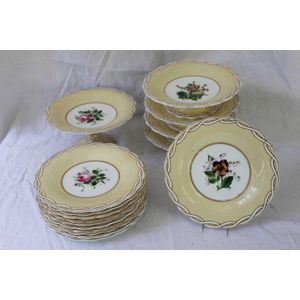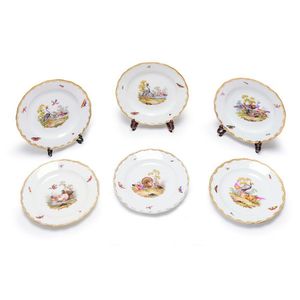English Porcelain Armorial Dishes, 19th Century
You must be a subscriber, and be logged in to view price and dealer details.
Subscribe Now to view actual auction price for this item
When you subscribe, you have the option of setting the currency in which to display prices to $Au, $US, $NZ or Stg.
- Armorial / Armourial - Bearing a coat of arms. Coats of arms came into general use by feudal lords and knights in in the 12th century, and by the 13th century, arms had spread beyond their initial battlefield use to become a flag or emblem for families in the higher social classes of Europe. They were inherited from one generation to the next. When a family crest is used on individual items of silver or furniture it is an indicator of the aristocratic standing of the family represented.
Armorials were also used to decorate mass produced ceramic souvenir ware by such companies as Goss, Carlton & Shelley, and in these cases the coats of arms displayed were of boroughs and cities. - Circa - A Latin term meaning 'about', often used in the antique trade to give an approximate date for the piece, usually considered to be five years on either side of the circa year. Thus, circa 1900 means the piece was made about 1900, probably between 1895 and 1905. The expression is sometimes abbreviated to c.1900.
This item has been included into following indexes:
-
Worcester (England), item types
- bowls 79
- pots and bowls 129
- Worcester (England), other - Barr Flight Barr / Flight, Barr & Barr 142
Visually similar items

A Minton botanical dessert service, comprising of four comports and eleven plates

Various Chinese blue and white porcelain bowls 20th century. Diameter largest 17.5 cm. Chips to one, hairline crack to another

Early 13 piece dessert set. Derby' including 11 plates & two various comports. All with painted blossom pattern, gilt rims. Depth 23 cm (plates)

A set of six Meissen porcelain plates, circa 1880, each plate hand painted with exotic birds to centre, and butterfly designs to rim, blue under glazed double sword mark to underside, 23.5 cm diameter
